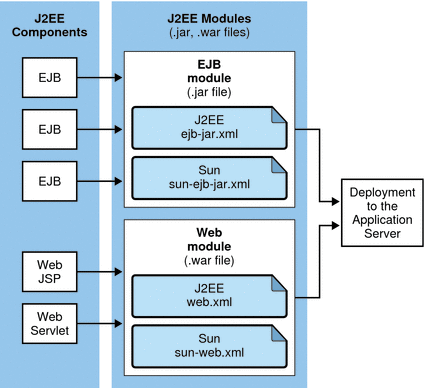Modules
A J2EE module is a collection of one or more J2EE components that execute in the same container type (for example, web or EJB) with deployment descriptors of that type. One descriptor is J2EE standard, the other is Application Server specific. Types of J2EE modules are as follows:
-
Web Application Archive (WAR): A web application is a collection of servlets, HTML pages, classes, and other resources that can be bundled and deployed to several J2EE application servers. A WAR file can consist of the following items: servlets, JSP files, JSP tag libraries, utility classes, static pages, client-side applets, beans, bean classes, and deployment descriptors (web.xml and optionally sun-web.xml).
-
EJB JAR File: The EJB JAR file is the standard format for assembling enterprise beans. This file contains the bean classes (home, remote, local, and implementation), all of the utility classes, and the deployment descriptors (ejb-jar.xml and sun-ejb-jar.xml). If the EJB component is an entity bean with container managed persistence, a .dbschema file and a CMP mapping descriptor, sun-cmp-mapping.xml, must be included as well.
-
Application Client Container JAR File: An ACC client is an Application Server specific type of J2EE client. An ACC client supports the standard J2EE Application Client specifications, and in addition, supports direct access to the Application Server. Its deployment descriptors are application-client.xml and sun-application-client.xml.
-
Resource RAR File: RAR files apply to J2EE CA connectors. A connector extends the EJB container to allow access to external systems much like a device driver provides access to a peripheral device from a process hosted by an operating system. It is a portable way of allowing EJB components to access a foreign enterprise system. Each Application Server connector has a J2EE XML file, ra.xml.
Package definitions must be used in the source code of all modules so the class loader can properly locate the classes after the modules have been deployed.
Because the information in a deployment descriptor is declarative, it can be changed without requiring modifications to source code. At run time, the J2EE server reads this information and acts accordingly.
The Application Server also supports lifecycle modules. See Chapter 10, Developing Lifecycle Listeners for more information.
EJB JAR and Web modules can also be deployed separately, outside of any application, as in the following figure. EJB components are assembled in a JAR file with ejb-jar.xml and sun-ejb-jar.xml deployment descriptors. Web components are assembled in a WAR file with web.xml and sun-web.xml deployment descriptors. Both module types are deployed to the Application Server.
Figure 3–1 Module assembly and deployment

- © 2010, Oracle Corporation and/or its affiliates
